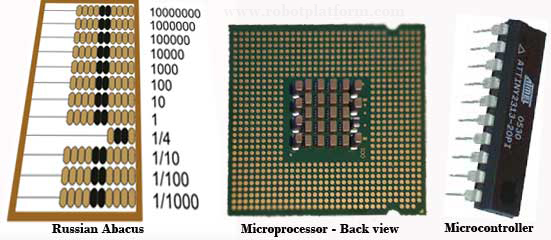Microcontroller
History of Microcontroller
Do you ever remember that there were days then people used an Abacus to do simple calculations? Those bulky wooden frames used to do basic arithmetic operations. This was followed by what we now call "the evolution of computers"; Vacuum tubes with their magnetic drums made an entry as the first generation computers. They were later replaced by transistors. Then there were integrated circuits or IC’s as an aid for the third generation computers. The revolution started when microprocessors were invented where thousands of integrated circuits were built in. At the heart of most computers lies a microprocessor which sits gently and does all the work within, be it watching a movie, or working on a spreadsheet.

As times changed, requirements increased and the size of the controllers (devices that control processes) decreased. We required a computer for everything. To wash our clothes, we needed a machine; to bake our food, we need a microwave oven; to entertain us, we need a Television and to operate it, a remote control, so on and so forth. As the process of miniaturization continued, those heavy controllers with additional components were etched or imprinted right onto a single microchip, often called a chip. It was like building an entire computer layer by layer on a semiconductor material such as silicon. These application specific microchips are called as “Microcontrollers”. If you are trying to understand what I mean, then your first question would be: “Is a microcontroller any different then a microprocessor used in a computer as per the description given”? Yes it is different. Let us see what a microcontroller is, its components, functions, uses and how is it different from a microprocessor. We will also see the different microcontrollers available in the market and the ones we use for our applications.
Microprocessor and Microcontroller:
To control the processing and execution of instructions inside a computer there rests a processor or a central processing unit (CPU) which contains an arithmetic logic unit (ALU) and a Control Unit (CU). A microprocessor is one such general purpose CPU. Additional components like RAM, ROM, internal circuitry, data bus, and other peripheral devices are added to make it a computer.
Now if you think of a microcontroller, this is a highly integrated chip in which most or all components needed for a controller like a CPU, RAM, ROM, timers, Input and Output pins, registers, clock circuit etc. are built within. They are small, powerful with limited speed and memory which can be used in embedded applications and for specific tasks.
In simple words, microprocessor along with its components is a general purpose computer used to run hundreds of applications at a time. On the other hand, microcontroller is a miniature computer used for specific purpose with its own limitations. Although there is a difference between the two in the real world, practically they use the same architecture and philosophy. Hence if you find the usage of microprocessor in any of the explanations below, they are a conscious effort to ease the understanding.
Microcontroller:
Microcontrollers (commonly written as µc or uc) have been with us for a few decades now but their impact is deep. They are normally embedded within other devices so that they can control the actions of those devices. Typically a microcontroller is used for three basic purposes:
- Receive input (via sensors, human intervention etc.,)
- Store and Process this input into a set of actions
- Apply the processed data for some other actions which goes as an output.
Do you have anything to say?
Visit the Forum to discuss, learn and share anything related to robotics and electronics !!








